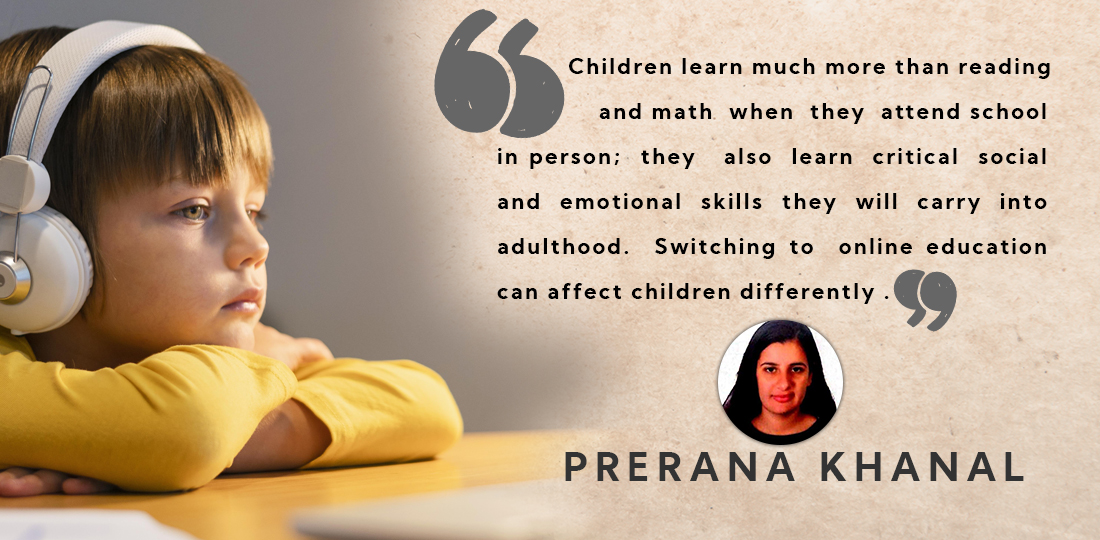Pandemic, Online classes and Children

Children learn much more than reading and math when they attend school in person; they also learn critical social and emotional skills they will carry into adulthood. Switching traditional education to online education can affect children differently.
The global outbreak of the COVID-19 pandemic has spread worldwide, affecting almost all countries and territories. The outbreak was first detected in December 2019 in China’s Wuhan Province.
Countries around the world have been asking the public to take responsive care. The public care habits include washing hands, wearing face masks, maintaining physical distance, and avoiding mass gatherings and assemblies. Enforcing lockdown and staying isolated at home have also been put in place in an attempt to flatten the curve and control the transmission of the disease.
The pandemic has created an unprecedented disruption in the education system in human history, affecting nearly 1.6 billion learners in more than 200 countries. The closure of schools, educational institutions and other learning spaces have impacted more than 94% of the world’s student population. Social distancing and restriction orders have significantly impacted traditional educational practices. Within a short span of the COVID-19 pandemic, many researchers have shared their works on teaching and learning in different ways. The need of the hour is to undertake innovation and implement alternative educational methodologies and assessment strategies.
Prior to the pandemic, one out of every 5 children, adolescents and youth globally were out of school. According to Nepal’s Ministry of Education, Science and Technology, the country is home to approximately seven million students, with more than five million enrolled in government-funded public schools between 2017 and 2018. On March 18, 2020, the federal government closed all schools and colleges in the country in order to curb the spread of COVID-19.In the meantime, there some attempts have been made to conduct classroom learning activities remotely, through broadcasts on television and radio and online platforms, though virtual options remain difficult in a country where access to the internet and computers is unevenly distributed. In fact, most schools don't even have internet connectivity, as noted in the 2020-2021 Economic Survey (Ministry of Finance), which reported that only 12 percent of public schools have the capacity to offer information and communication technology- (ICT) based learning.
Despite having significant strength and unprecedented accessibility to quality education, there are weaknesses inherent in the use of this medium that can pose potential threats to the success of any online program. Before any online program leads to success, it must have students who are able to access the online learning environment. Lack of access, whether it be due to economic or logistic reasons,will exclude otherwise eligible students from the course which is a significant issue in a country like Nepal. Both the students and facilitator must possess a minimum level knowledge of various kinds of digital applications like ; Zoom, Google Meet, MS Teams, and many more to function successfully in an online environment . However, disruption at any point during online sessions due to limited internet access or sometimes due to power cut-off is liable to impact the smooth teaching-learning activity. In such a situation, the technology is neither seamless nor reliable and can detract from the learning experience.
Beyond the educational impacts of online learning are its developmental impacts. Children learn much more than reading and math when they attend school in person; they also learn critical social and emotional skills they will carry into adulthood. Switching traditional education to online education can affect children differently. It is found that many students are skipping classes and playing games online instead of focusing on their classes. Students are socially isolated during online classes which has reduced interactions with their family members. Children remain unmotivated these days due to lack of group work , group presentation and many other activities which used to be in schools. They are forced to work in isolation which results in a lack of motive and confidence within them.
The uncertainty and disruption of the pandemic, coupled with the subsequent shift to online learning, can take an emotional toll on children. Additionally, according to the National Survey on Drug Use and Health, 3.7 million children ages 12-17 receive mental health services at school,but they are not at school to receive it. The social isolation a child may feel during online education can lead to depression. Children may be worried about themselves or family members contracting COVID-19. They may have loved ones who are sick with the virus or may have lost a family member. Parents are concerned about the long-term effects of online learning on their children. Parents, teachers, and students were blindsided when the pandemic forced schools across the country to close. Even as some schools have begun to reopen, others have remained closed and millions of students are still learning remotely to some degree.
As the impact of online education becomes more apparent, families and educators can learn valuable information and use this as an opportunity to grow.









Leave Comment